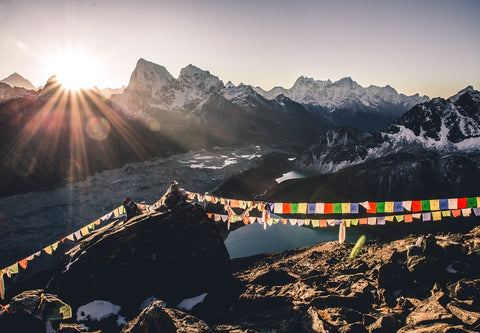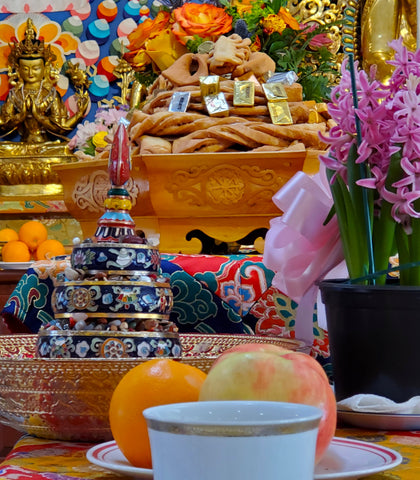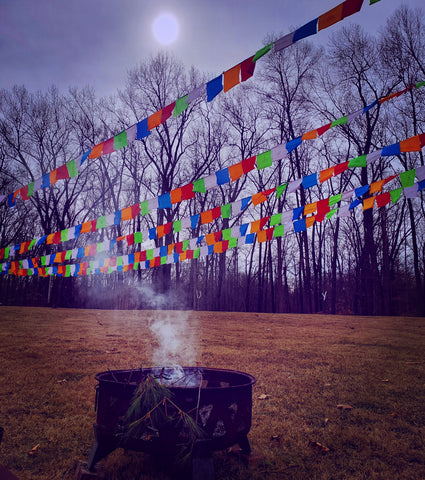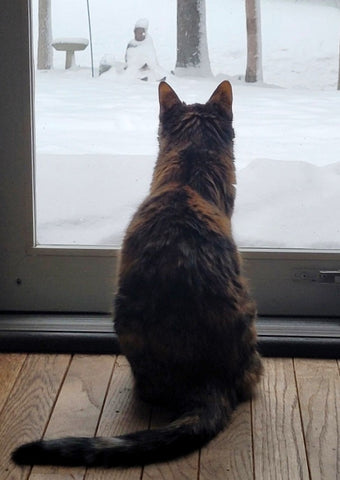News
Peaks and Valleys of Practice: The Flexibility of Familiarity February 26, 2024 18:35

If you prefer to listen to this month's offering, please click HERE for the audio link.
It’s Saturday afternoon, and I’m sitting at a small café table in Barnes and Noble with my daughter. I ordered a cinnamon tea; she ordered a chai latté and we’re splitting an oatmeal raisin cookie. In the background, we can hear the intermittent hiss of the cappuccino machine and the low murmuring of voices at surrounding tables. It’s nice to have time to visit and chat with her. It reminds me of the many hours we enjoyed at Borders years ago—she’d read or work on homework, and I’d grade papers.
February has brought with it many peaks and valleys. Time spent with Elise in a local bookstore is definitely a peak.
Earlier this month, I celebrated Losar, the Tibetan Lunar New Year, with Dharma friends in Bloomington. We celebrated with a purifying smoke puja under freshly hung prayer flags behind the temple. Then, we gathered inside the temple for long life prayers, tea, and sweet rice. Afterwards, we ate lunch in the cultural building and had time to chat with friends.

I enjoyed watching the Tibetan dances, and I especially enjoyed seeing all the little ones in their brocaded chupas and traditional dress. It truly was a wonderful day of celebration and meaningful connection. I didn’t know many of the people who attended; some came from out of state just for this celebration. It didn’t matter—it felt like we were among family members throughout the day. Our love of Tibetan culture and Dharma practice brought us all together. This celebration was definitely a highlight as well.

I am very grateful for having a daily Dharma practice. One of the benefits is that it helps me feel connected to others, even those I’ve never met before, in a meaningful, authentic way. A daily practice definitely helps me appreciate these sweet moments of celebration with others.
However, and probably more importantly, my practice helps me to navigate frustrating times, too. This past week, we had to arrange for our cat, Zora, to have dental surgery. She’s an older kitty, and she takes two different medications to manage seizures and a wonky thyroid. I worry about how she’ll do under anesthesia, as well as her follow-up recovery.
In addition to her health concerns, we had someone randomly cut our phone and internet line. There are several construction projects happening in our area, and our line was cut, which interrupted our phone and internet service for a day or so.
Last Wednesday evening, I was navigating my way through an online chat with a Brightspeed robot on my cell phone to arrange for a technician to come out and trouble shoot our outage. I was also in the process of making dinner. While I was chopping onions, boiling water for pasta, and chatting with a robot, the vet calls on Jim’s cell phone, which he left on the kitchen table while he was outside shooting his bow for archery practice.
So, I’m in the middle of trying to do three important things at the same time. Needless to say, I was a bit flustered and rattled, but I managed to stay relatively calm. I didn’t burn dinner, I was eventually able to schedule and confirm a tech visit, and the vet patiently repeated her instructions so that I could clearly process what she was saying.
Afterwards, when things settled down, I looked forward to my practice. During stressful and chaotic times, it helps me to stay calm and steady. The familiarity of the practice is soothing and comforting, and it helps me to focus on something positive.
Later in the week, during the Sunday Dharma teaching in Bloomington, Minyak Rinpoche said something that really resonated with me. He said, “Everything depends upon the flexibility of familiarity.”
In other words, having a daily practice to rely on helps foster a flexible mindset. I have definitely found that a daily practice helps me to navigate unexpected pivots and surprises. It offers a steady foundation in the face of constant change.
I’ve also noticed that it’s during stressful times when I realize how well my practice is actually serving me (and others). It’s also during these chaotic times that I learn how effectively, and mindfully my practice has been. Stressful times also reveal where my weak spots are—and in what areas I still need to grow.
Am I just saying the words and going through the motions of the practice? Or, am I taking enough time to contemplate and analyze the meaning of what I’m reading or saying? Most importantly, am I applying what I’m practicing to my everyday life?
If I can remain calm during challenging times, and in the aftermath of challenging times, I know I’m on the right path. If I get agitated and flustered, I know I have work to do.
Last night, I spent over an hour in the kitchen tending to Zora—encouraging her to eat her food. It’s a slow process. She takes a few bites, then walks away. She comes back around to take another bite, then walks away again. If I walk away, she won’t eat at all, but if I stay in the kitchen, she’ll keep returning.
We have to keep a close eye on Maya, our Yorkie, who is more than happy to eat her food, and doesn’t care that it’s laced with medications that she does not need.
During this hour, I wasn’t stressed. I was present, patient, and calm. I made dinner. I washed dishes. I listened to the news. In between, I pushed her food into a small pile on her plate to entice her to continue eating. This pile slowly dwindled over the course of the hour.
Afterwards, when she finally finished her food, I felt emotionally drained, stressed, and scared. My anxieties about her upcoming surgery resurfaced. I wound up snapping at Jim and stomped upstairs to stress-vacuum the floor.
This is how I know I need to continue to practice—and that I need to continue to fine-tune my practice. I’m currently able to stay fairly steady and calm in the middle of the chaos, but not after the chaos has passed.
Moments like these make me realize how important it is to take quality time--
to sit on my cushion and meditate,
to mindfully recite mantra,
to read Dharma texts or listen to Dharma talks,
and to engage is some kind of purification practice
EVERY DAY!!!!
Moments like these help me recognize the progress I’ve already made, and I have made slow, steady progress, much like Zora returning to her dwindling plate of food in the kitchen. These moments help me to appreciate how much I’ve changed for the better, and they also motivate and encourage me to continue to keep practicing in order to move forward on the path.

I hope that you are navigating all of the peaks and valleys of your life with skill, grace, courage, and patience. If a beautiful, hand-knotted mala would enhance and inspire your practice, please visit the MMM online shop. Send me a message via the Contact Us page if you are interested in a custom design. I’d be happy to create a beautiful mala or quarter mala design that’s just right for you and your practice.
The Benefits of Motivation and Curiosity: On the Road and in a Meditation Practice July 31, 2021 16:55

(photo credit: Muhammad owsama via Unsplash)
If you prefer to listen to this month's blog post, please click here for the audio link.
These past few weeks, I have been grateful to be able to drive to Bloomington to attend Dharma teachings in-person at TMBCC (Tibetan Mongolian Buddhist Cultural Center).
The center is now open for weekly teachings, and visitors are required to wear masks (an act of compassion that protects themselves and others).
An ongoing (and major) construction project is happening on State Road 37, which is the road I usually take to B-town. Part of this highway is closed, and a detour is required in order for me to reach my destination. The orange cones, "rodeo barrels," and ever-changing traffic patterns with unexpected curves and sharp turns make this weekly commute a continual surprise. The road is forever morphing and changing.
However, dedication, curiosity, and motivation inspire me to navigate my way back and forth each Sunday. I wake up a little earlier. I leave the house a little sooner, and I keep an open, judgment-free mind. Expectations typically create unwanted limitations, and they are a sure-fire way to set myself up for disappointment and stress.
I type in the address on the GPS system in my car and follow the directions (usually--a few rebellious "route recalculations" are part of the fun). Each time I've taken this trip, my car has led me on a different route.
I'm exploring new pathways.
I'm trusting the guidance.
I'm open to discovery, and I'm curious about the journey.
This is SIGNIFICANT growth for me. I am notoriously bad at directions, and I get lost and turned around very easily. As a result, getting lost used to be quite anxiety-triggering for me...to the point that it would prevent me from exploring new places and experiences.
I'm also not usually thrilled about driving long distances, either. This commute takes me well over an hour each way. However, I have been enjoying these excursions. I'm more relaxed and patient in the car. I'm less fearful and more open. I'm less disoriented and more curious. I don't worry about the time as much as I used to, and I have enjoyed taking in the new scenery each week.
I'm not sure what's changed, but because my motivation is strong, I'm more flexible, accepting, and eager to discover new pathways.
Meditation practice is like this, too.
Meditation is a method of self-regulation. Over time, a regular practice regulates my thoughts, which can trigger a relaxation response in the body.
Scientific studies have shown that meditation can reduce inflammation, which can ward off harmful disease. Meditation can increase insulin production, which can improve blood sugar regulation in the body. Meditation can also have anti-aging effects by preserving the ends of chromosomes (called telomeres).
Consequently, training the mind through a regular meditation practice can indirectly affect the expression of genes and influence the production of hormones. In other words, meditation can affect your body on a cellular level!
It can also encourage the growth of new neural pathways in the brain. This process is also known as self-directed neuroplasticity. Neuroplasticity is the brain's ability to adapt to change. The environment, thoughts, and actions can influence the brain's ability to create these new neural pathways.
A regular meditation practice can improve the ability to focus and remain present. It can lead to reduced stress and anxiety, and it can also enhance and improve intuition and interoception (an awareness of sensations inside the body).
Meditation naturally leads to improved self-awareness and self-regulation. It can also prevent age-related brain atrophy and protect against memory loss. Meditation retrains the brain to become more fully present and to rely less on living unconsciously on "auto-pilot."
It's not easy to break away from ingrained habits--to bust out of the status quo and embrace new things.
Change is possible.
Growth is possible.
Where you choose to place your attention determines the quality of your life.
Personally, meditation has encouraged me to take more responsibility for my life. I feel more confident, and I'm more willing to explore new experiences and interests. I'm also less judgmental and fearful.
So, maybe not being able to travel to Bloomington and attend Dharma teachings in-person for several months gave me more time to meditate at home and hone my own self-directed neuroplasticity skills.
And, maybe all of these construction projects with their detours and alternate routes are pushing all of us, gently, out of our well-worn habits and encouraging us to explore and appreciate the scenery of unknown roads.
The path to awareness is both a physical and mental journey, and being open, curious, and motivated will help make this journey more meaningful and enjoyable.
Speaking of enjoying your practice--I have added several new mala designs to the online shop. Feel free to check out the full collection here.
Hitting the Reset Button: Retreat and Recharge April 3, 2017 13:46

The only thing that matters is this breath. The only thing that matters is slicing this apple. The only thing that matters is this step. The only thing that matters is this blue heron taking flight over a pond.
I recently spent three days in a secluded cabin at the Tibetan Mongolian Buddhist Cultural Center in Bloomington, Indiana, for a personal retreat. I needed a little time to unplug (literally and metaphorically) from the world and to reconnect with myself and my practice.
I stayed in a circular, yurt-inspired cabin. It had a small kitchen, a domed skylight , walls painted a soothing sea foam green, plenty of floor space for yoga practice, and a deck with a view of the woods.
During my stay, I made serenity a priority. I practiced yoga every morning before breakfast and every evening before going to bed. I wandered in the woods and grounds of the Center in between stints of light rain showers. I circumambulated the Kalachakra Stupa while chanting. I ate meals mindfully. I meditated on the deck. I strung beads on a mala. I chatted briefly with gray squirrels, attendants at the nearby gift shop (The Happy Yak), Geshe Kunga on his way to the temple, and an aging, but friendly pug named Norbu.
For three days, I paid close attention to sounds that I’m not accustomed to hearing—wind chimes, fluttering prayer flags, rain on the roof, squirrels skittering on the deck. I took time to enjoy food—to savor every bite—sliced oranges in a bowl, raspberry cheesecake, toast with Marionberry jam, Greek yogurt with spiced butternut squash and apricots. I watched the sunrise between the trees and the stars from the skylight.
No obligations or interruptions, no striving or planning, this retreat was all about allowing and being. My headaches (and hot flashes) subsided; my stress levels decreased dramatically. By releasing the usual day-to-day distractions, it allowed me to connect more deeply to myself and the environment.
I look forward to visiting TMBCC again for future retreats. In the meantime, I can choose to find stillness and serenity in this moment, regardless of where I am. I can choose to make my meditation/chanting practice a priority every day, beginning each day with recitations,instead of postponing it to the end of the day when I am mentally and physically fatigued. I can choose to unplug from the frenetic busyness of my day-to-day life for just a few minutes in order to reboot and recharge energetically.
The only thing that matters is this breath. The only thing that matters is this traffic light. The only thing that matters is this student who will deliver her speech in an hour. The only thing that matters is this sip of lukewarm chai tea.
Relax and Allow: How a Mantra Practice Can Invite an Appreciation for the Present Moment November 1, 2016 00:00
As often as I can, I like to go to the Tibetan Mongolian Buddhist Cultural Center in Bloomington on Sundays for a morning lecture. This past Sunday, Geshe Kunga presented a teaching on patience. During these lectures, Geshe Kunga speaks in Tibetan, and another monk, who’s actually in Virginia, translates via Skype on a small laptop. I know, it sounds like a scene from Lost, but I actually look forward to these weekly “Dharma transmissions.”
Last Sunday, the weather was absolutely beautiful. The double doors on both sides of the main room in the temple were open, letting in mild breezes and the sounds of rustling leaves and birdsong.
The view to my left was especially scenic, and my gaze kept drifting toward it throughout the lecture. My student self was listening to Geshe and the cyber monk, but my artistic self was growing a little antsy. I had my camera with me in my bag, and I wanted to capture a photo of the open door—the sunlight streaming through lace curtains, the contrast of the brightly painted temple walls against the shadows of falling leaves, the literal threshold between the manmade and the natural. It was stunning….and very distracting.
My attention was divided, and I was holding the tension associated with grasping and clinging attachment. I could feel it in my body and mind. Technically, I could have taken a photo during the teaching, but it would have been weird. The room is small; there were only a dozen or so practitioners in attendance, but it was a lecture in a temple, not a scenic overlook or tourist attraction.
I mentioned that the lecture was about patience….so, I waited. At the end of class, after the bows and prostrations, I returned to my cushion, and just as I was lining up the shot, Geshe Kunga walked across the room to close one of the doors and was headed to the second set to close it, too, in preparation for the prayer session after lunch. I had just enough time to grab my camera, focus, and snap the shot just as the door shut.
The photo was not what I had expected, and it wasn’t the shot that I thought I had wanted. It was better. It was better than anything that I could have planned or anticipated.
The universe keeps giving me opportunities to relax and allow. The more present I can be without clinging to attachments or preconceived notions, the more I can enjoy and receive the benefits of what these moments have to offer.
One of the best ways for me to practice this present-moment acceptance is through japa. Reciting mantras with a mala helps to still the obsessive thoughts and the constant anticipation and planning that goes on in my head. The repetition of the mantra itself is soothing, and each complete circuit of a mala is a way for me to mark time with presence. I can relax and allow into this practice, which permits me to relax, allow, and enjoy other aspects of my life as well.
Celebrating Sweet and Savory Choices August 2, 2016 11:31

We have choice, and our choices direct our paths. They may not define us, but they do lead us from one moment to the next. Each experience—each moment, has something unique to teach us.
This morning, I chose to drive to Bloomington to attend a lecture at the Tibetan Mongolian Buddhist Cultural Center. Afterwards, I chose to go to Anyetsang’s Little Tibet for lunch. I do not regret either choice.
Currently, I’m sitting under a red patio umbrella. A late summer breeze teases colorful prayer flags overhead. I can hear the sounds of a fountain gurgling behind me. Cicadas are grinding away the hot afternoon in their shrill, spiral cries as steady traffic hums along 4th Street.
I have the patio mainly to myself, and I have the time and freedom to enjoy a mango lassi—and to savor every bite of the cabbage dumplings—pan-seared and served with soy sauce. A sparrow hops around under my table, and heads of black-eyed Susans gently nod in encouragement.
I am at ease. I am at peace. I am savoring this present moment.
Earlier, I had considered stopping by the Jordan Greenhouse on the IU campus to see Wally, the titan arum, or corpse flower, in full bloom. The corpse flower blooms only once every ten to twenty years, and it emits a strong odor similar to the stench of rotting flesh. It’s a botanical wonder, and seeing this plant in full bloom would be a once-in-a-lifetime opportunity. However, vegetarian momos were calling my name, so I chose Little Tibet over Wally. Besides, isn’t every moment a once-in-a-lifetime opportunity? (I Googled Wally later in the day and watched him unfold online--so this choice was a win-win).
Every choice we make carries effects or consequences. The more mindful and present we are, the more mindful and present our choices are. Our lives are like malas, in this way. The beads represent the beautiful aspects of life (prayer flags, sunshine, momos), and the knots represent the challenges (the stench of rotting flesh). Challenge and beauty are interconnected and balanced, and as we progress through the circuit of our lives from moment to moment, we have the choice to be present—to learn from each experience—to enjoy and savor each bead and knot of our lives.

